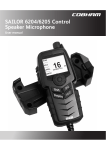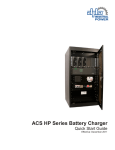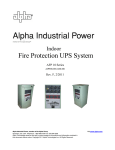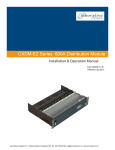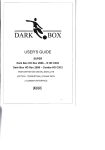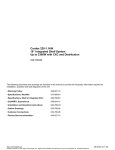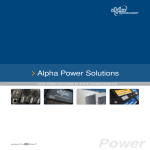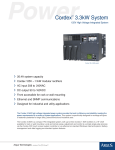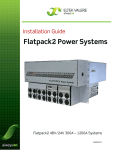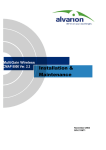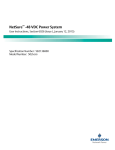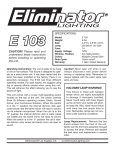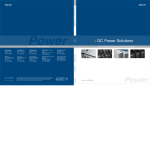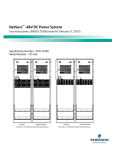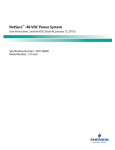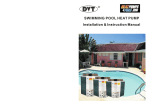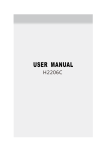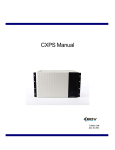Download CXPS-E103 48Vdc - User manual
Transcript
CXPS-E103 166A -48Vdc Power System Installation & Operation Manual Innovative Energies Ltd. 1 Heremai Street, Henderson NZ. Tel: +64 9 835 0700. [email protected]. www.innovative.co.nz IMPORTANT SAFETY INSTRUCTIONS SAVE THESE INSTRUCTIONS This section contains important instructions that must be followed during the installation and maintenance of the equipment and batteries. Read all of the instructions before operating the equipment, and save this manual for future reference. All electrical connections must be performed by licensed electricians only. Installation of the power supply and batteries must be performed by, or under the direct supervision of, service personnel knowledgeable of the required electrical and battery safety procedures. If instructions in this manual conflict with the local electrical codes, follow the local codes. The following safety symbols are found throughout this manual. Carefully read all information and abide by the instructions: DANGEROUS VOLTAGE This symbol indicates a dangerous voltage exists in this area of the product. GAS HAZARD This symbol indicates a gas hazard exists in the area of vented batteries. NO MATCHES OR OPEN FLAMES This symbol indicates a fire or explosive hazard exists in the area of the product. The following warning levels are used in conjunction with the symbols: DANGER: You WILL be KILLED or SERIOUSLY INJURED if instructions are not followed closely. WARNING: WARNING presents safety information to PREVENT INJURY OR DEATH to personnel. CAUTION: CAUTION indicates safety information intended to PREVENT DAMAGE to material or equipment. Mechanical safety Keep hands and tools clear of fans. Fans are thermostatically controlled and switch on automatically. Power supplies can reach extreme temperatures under load. Use caution around sheet metal components and sharp edges. 0540571-J0 Rev A Page i of v Electrical safety WARNING: Hazardous voltages are present at the input of power systems. The DC output from rectifiers and batteries, though not dangerous in voltage, has a high short-circuit current capacity that may cause severe burns and electrical arcing. Before working with any live battery or power system, follow these precautions: • • • Remove all metallic jewelry, such as watches, rings, metal rimmed glasses, or necklaces. Wear safety glasses with side shields at all times during installation. Use OSHA approved insulated hand tools. DANGER: Lethal voltages are present within a power system. Always assume that an electrical connection or conductor is energized. Check the circuit with a voltmeter with respect to the grounded portion of the enclosure (both AC and DC) before performing any installation or removal procedure. Do not work alone under hazardous conditions. A licensed electrician is required to install permanently wired equipment. Input voltages can range up to 240Vac. Ensure that the utility power is disconnected and locked out performing any installation or removal procedure. Ensure that no liquids or wet clothes come into contact with internal components. Hazardous electrically live parts inside this unit are energized from the batteries even when the AC input power is disconnected. Battery safety • • • • • • Battery Installation and servicing should be performed or supervised by personnel knowledgeable about batteries and the required precautions performed. Be extra cautious when connecting or adjusting battery cabling. An improperly connected battery cable or an unconnected battery cable can result in arching, fire or explosion. Before attaching the batteries, make sure that the polarity is correct. Use new batteries when installing a new unit. Verify that al batteries are the same type with identical date codes When replacing batteries, use sealed lead acid batteries, rated 12V. Never install old or untested batteries Batteries that show signs of cracking, leaking or swelling must be replaced immediately by authorized personnel using a battery of identical type and rating. CAUTION: Never open, damage or mutilate batteries. Released Electrolyte is harmful to the skin and eyes. It may be toxic and hazardous to the environment. • • • Never dispose of batteries in a fire. The batteries may explode. Follow the manufacturer’s directions and check with your local jurisdictions for safe battery disposal. If electrolyte splashes on your skin, immediately wash the affected area with water. If electrolyte gets into your eyes, wash them for at least 10 minutes with clean running water or special neutralizing eye wash solution. Seek medical attention at once. Neutralize spilled electrolyte with special neutralizing solution and a “spill kit” or solution of 1 lbs (0.45KG) of baking soda (bicarbonate of soda) in 1 gallon (3.8 L) of water. CAUTION: A battery can present a risk of electrical shock and high short-circuit current. The following precautions should be observed when working on batteries: 0540571-J0 Rev A Page ii of v • • • • • • • • • Remove watches, rings or other metal objects. Use tools with insulated handles. Wear rubber gloves and boots. Do not lay tools or metal parts on the top of batteries. Disconnect the charging source before connecting or disconnecting battery terminals. Determine if the battery is inadvertently grounded. If inadvertently grounded, remove the source from the ground. Contact with any part of the grounded battery can result in electrical shock. The likelihood of such shock can be reduced if the grounds are removed during installation and maintenance (applicable to equipment and remote battery supplies not having a grounded supply circuit). Do not smoke or introduce sparks in the vicinity of a battery. If the batteries have been in storage for more than 3 months, recharge them for at least 24 hours and then test them with a load before installation. TM Each AlphaCell battery has a date code found on the warning label which must be recorded in the maintenance log. If non-Alpha batteries are used, see the manufacturer’s documentation for date code type and placement. Post installation weather proofing After installing the conduits and removing any knockouts to accommodate conduit locations, ensure that any gaps between the conduit fittings and the shroud are sealed. Apply a weatherproof caulking to gaps to prevent wind driven rain from reaching the electrical equipment. 0540571-J0 Rev A Page iii of v TABLE OF CONTENTS 1 INTRODUCTION ............................................................................................................................................................ 7 1.1 Manual scope .................................................................................................................................................. 7 1.2 Product overview ............................................................................................................................................. 7 1.3 Part numbers, including options ...................................................................................................................... 8 2 FEATURES .................................................................................................................................................................. 9 2.1 System overview ............................................................................................................................................. 9 2.2 Distribution panel ............................................................................................................................................. 9 2.3 Controller ....................................................................................................................................................... 10 2.4 LED lights ...................................................................................................................................................... 12 2.5 Rectifiers ........................................................................................................................................................ 13 2.6 Rectifier front panel ....................................................................................................................................... 14 2.7 Rectifier Rear Panel....................................................................................................................................... 15 2.8 True Module Fail Alarm ................................................................................................................................. 15 2.9 Heat Dissipation ............................................................................................................................................ 16 2.10 Over Temperature Protection ...................................................................................................................... 16 2.11 Wide AC Range ........................................................................................................................................... 16 2.12 AC Inrush/Transient Suppression ................................................................................................................ 16 2.13 Soft Start ...................................................................................................................................................... 16 2.14 Start Delay ................................................................................................................................................... 16 3 LED INSPECTION ...................................................................................................................................................... 18 3.1 Packing materials .......................................................................................................................................... 18 3.2 Check for damage ......................................................................................................................................... 18 3.3 General receipt of shipment .......................................................................................................................... 18 4 INSTALLATION ........................................................................................................................................................... 19 4.1 Safety precautions ......................................................................................................................................... 19 4.2 Tools required ................................................................................................................................................ 19 4.3 Power system assembly and mounting ......................................................................................................... 19 4.4 Rectifier module insertion/removal ................................................................................................................ 20 4.5 Breaker installation ........................................................................................................................................ 21 4.6 Breaker Removal ........................................................................................................................................... 21 4.7 Battery installation ......................................................................................................................................... 22 5 WIRING ..................................................................................................................................................................... 24 5.1 Grounding ...................................................................................................................................................... 24 5.2 AC feeder protection/sizing ........................................................................................................................... 24 5.3 AC input connections ..................................................................................................................................... 24 5.4 Calculating output wire size requirements ..................................................................................................... 25 5.5 DC output connections .................................................................................................................................. 25 5.6 System and battery connections ................................................................................................................... 25 5.7 Chassis Ground and Return Bus Bar Connections ....................................................................................... 26 5.8 Distribution Cabling ....................................................................................................................................... 27 5.9 Alarm and Signal Connections ...................................................................................................................... 29 5.10 CAN serial ports .......................................................................................................................................... 29 5.11 Network connection and remote communications via controller.................................................................. 29 0540571-J0 Rev A Page v of 40 5.12! Signal wiring connections for controller ....................................................................................................... 30! 6! SYSTEM STARTUP ............................... . ............................... . ............................... . ............................... . .................... . 32 ! 6.1! Check system connections ............................................................................................................................ 32! 6.2! Verify AC input and power up rectifier shelf .................................................................................................. 32! 6.3! Check battery polarity and connect the batteries .......................................................................................... 32! 6.4! Controller reset .............................................................................................................................................. 32! 6.5! LVD control .................................................................................................................................................... 33! 7! OPERATION ............................... . ............................... . ............................... . ............................... . ............................. . 34 ! 7.1! Main rectifier states ....................................................................................................................................... 34! 7.2! Main rectifier modes ...................................................................................................................................... 35! 7.3! Factory ranges and defaults .......................................................................................................................... 35! 8! MAINTENANCE ............................... . ............................... . ............................... . ............................... . ......................... . 37 ! 8.1! General maintenance schedule ..................................................................................................................... 37! 8.2! Fan replacement ............................................................................................................................................ 37! 8.3! Trouble Shooting ........................................................................................................................................... 38! 9! WARRANTY AND SERVICE INFORMATION ............................... . ............................... . ............................... . ................... . 39 ! 9.1! Technical Support .......................................................................................................................................... 39! 9.2! Warranty ........................................................................................................................................................ 39! 9.3! Battery Warranty ............................................................................................................................................ 39! 9.4! Return of Material .......................................................................................................................................... 39! 10 ! CONVENTIONS ............................... . ............................... . ............................... . ............................... . ............................... . 40 ! 10.1! Acronyms ..................................................................................................................................................... 40! FIGURES Figure 1 Front view of 0540571-001 CXPS-E103 48V 166A configuration .................................................................... 7! Figure 2-Front panel status indicators ............................................................................................................................. 9! Figure 3 CXDM-E1 rear battery and load breakers connections ................................................................................. 10! Figure 4 LVBD override switch (front cover removed) .................................................................................................. 10! Figure 5 Controller front panel ...................................................................................................................................... 12! Figure 6 Rectifier front panel ........................................................................................................................................ 14! Figure 7 Inserting a rectifier into the shelf .................................................................................................................... 20! Figure 8 Removing a rectifier from the shelf................................................................................................................. 20! Figure 9 Breaker Removal Tools ................................................................................................................................ 21! Figure 10 Ground and return bus bar connections ....................................................................................................... 26! Figure 11 Battery / rectifier bus bar connections .......................................................................................................... 27! Figure 12 Battery, load, and return connection locations (with battery and load breakers shown) .............................. 28! Figure 13 Alarm and Signal Connections ................................................................................................................... 29! Figure 14 Showing relay connections .......................................................................................................................... 30! Figure 15 Showing digital input connection method ..................................................................................................... 31! 0540571-J0 Rev A Page vi of 40 1 Introduction 1.1 Manual scope This manual covers the features and installation of the CXPS-E103 series 166A -48Vdc power system. Specification: Schematics: Outline drawings: Customer connection drawings: 1.2 0540571-S0 0540571-05 0540571-06 0540571-08 Product overview The CXPS-E103 series power system is a complete integrated 166A -48Vdc power system. Each system uses the advanced Cordex CXCI+ controller and HP CXRF 48-2.0kW rectifier modules. The CXDM-E1 1RU 225A distribution panel provides front access for DC distribution circuit breakers. Cordex rectifier modules use a high frequency, switched mode conversion technique to provide a fully regulated and isolated DC output from the AC mains. The rectifier input accepts a wide range of input voltages, allowing the flexibility to connect to supply mains rated 120/208/220/230/240/277 Vac, 50/60 Hz. The system has de-rated output below 176Vac input. See specifications at the end of this manual. cutting power to or from the system or the load. Rectifier modules are not included with the base system, but may be purchased along with the system at the time of ordering, or added after the shelf has been installed. The shelf rectifier system includes the Cordex CXCI+ modular controller. This system uses the controller integrated version of the controller, which is factory installed on the Cordex rectifier system shelf. The CXCI+ allows the user to configure, monitor and control the entire DC power system locally or remotely via a web browser. Features of the unit include temperature compensation, auto equalization, remote access, e-mail alarm notification, battery diagnostics, as well as web server and SNMP support for configuration and monitoring. Details of the controller operation are provided in the software manual. Figure 1 Front view of 0540571-J0 Rev A 0540571 -001 CXPS -E103 48V 166A c onfiguration Page 7 of 40 Available system configurations The system is available in the following configurations: Description Part Number CXPS-E103, Standard 48V 166A power system, 19/23" rail mount, with LVBD................................... 0540571-001 1.3 Part numbers, including options This product is available with the following options and accessories: Description Part Number Cordex HP 48-2.0kW rectifier power module ..................................................................................... 010-622-20-040 Breaker, AM-type mid-trip plug-in, 1A ....................................................................................................... 470-300-10 Breaker, AM-type mid-trip plug-in, 3A ....................................................................................................... 470-301-10 Breaker, AM-type mid-trip plug-in, 5A ....................................................................................................... 470-302-10 Breaker, AM-type mid-trip plug-in, 10A ..................................................................................................... 470-303-10 Breaker, AM-type mid-trip plug-in, 15A ..................................................................................................... 470-304-10 Breaker, AM-type mid-trip plug-in, 20A ..................................................................................................... 470-305-10 Breaker, AM-type mid-trip plug-in, 25A ..................................................................................................... 470-306-10 Breaker, AM-type mid-trip plug-in, 30A ..................................................................................................... 470-307-10 Breaker, AM-type mid-trip plug-in, 35A ..................................................................................................... 470-308-10 Breaker, AM-type mid-trip plug-in, 40A ..................................................................................................... 470-309-10 Breaker, AM-type mid-trip plug-in, 45A ..................................................................................................... 470-310-10 Breaker, AM-type mid-trip plug-in, 50A ..................................................................................................... 470-311-10 Breaker, AM-type mid-trip plug-in, 60A ..................................................................................................... 470-312-10 Breaker, AM-type mid-trip plug-in, 70A ..................................................................................................... 470-313-10 Breaker, AM-type mid-trip plug-in, 80A ..................................................................................................... 470-314-10 Breaker, AM-type mid-trip plug-in, 90A ..................................................................................................... 470-315-10 Breaker, AM-type mid-trip plug-in, 100A ................................................................................................... 470-316-10 Load breaker, AM-type mid-trip plug-in, 125A (2 pole) ............................................................................. 347-523-20 Load breaker, AM-type mid-trip plug-in, 150A (2 pole) ............................................................................. 347-524-20 Load breaker, AM-type mid-trip plug-in, 200A (2 pole) .......................................................................... 7400383-001 Battery breaker, AM-type series-trip plug-in, 60A ..................................................................................... 470-346-10 Battery breaker, AM-type series-trip plug-in, 100A ................................................................................... 470-347-10 Battery breaker, AM-type series-trip plug-in, 125A ....................................................................................... 4700187 Battery breaker, AM-type series-trip plug-in, 150A (2 pole) ...................................................................... 747-503-20 Battery breaker, AM-type series-trip plug-in, 200A(2 pole) .................................................................... 7400345-001 Replacement CXCI+ controller .............................................................................................................. 7400232-001 Temperature sensor assembly 12 ft, ¼" lug ...................................................................................... 747-028-20-072 Temperature sensor assembly 12 ft, ⅜" lug ...................................................................................... 747-082-20-072 The above information is valid at the time of publication. Consult factory for up-to-date ordering information. 0540571-J0 Rev A Page 8 of 40 2 Features 2.1 System overview Basic 166A configuration included in IE part number 0540571-001: CXDM-E1 high density 1U 225A distribution center Cordex CXCI+ system controller One (1) Cordex HP 48-2.0kW rectifier shelf (four positions total) Kydex rear cover User switchable 19" rack mount bracket for center and flush mount 19" to 23" rack mount adaptors Rectifier modules, DC distribution breakers, temperature probes and AC input cables are not included in the basic configuration. See section 1.3 to order these optional components. 2.2 Distribution panel 2.2.1 Status Indicators LEDs, located on the front panel, indicate the following status: POWER (Green): Power to the shelf INHIBIT (Yellow): LVD switch in override ALARM (Red): Breaker tripped Figure 2-Front panel status indicators 0540571-J0 Rev A Page 9 of 40 2.2.2 Distribution Configurations The CXDM-E1 contains 12 total plug-in breaker positions with two-hole lug connection points for both breaker output and the return bus. The breaker distribution is configured as 10 load breaker positions and 2 battery breaker positions as shown in Figure 3. NOTE: Use mid-trip plug-in breakers as load breakers, and series-trip plug-in breakers as battery breakers. Battery breaker connections Load breaker connections Figure 3– CXDM-E1 rear battery and load breakers connections 2.2.3 Low Voltage Battery Disconnect (LVBD) A 200A LVBD is installed in series with the batteries. The LVBD override switch is located behind the front panel, which can be removed by loosening the thumbscrews. The switch can then be used to override LVBD contactor operation as a safeguard during controller maintenance. The yellow INHIBIT LED is on when the switch is engaged. Figure 4–LVBD override switch (front cover removed) 2.3 Controller Details of the controller operation are provided in the software manual. The controller is mounted in the rectifier system shelf and controls the rectifiers. The motherboard, located behind the controller front panel, contains a microprocessor, memory chips, and other electronic components. Functions of the controller operation include the following: 0540571-J0 Rev A Page 10 of 40 • • • • • • Direct communication with the rectifiers Battery temperature compensation charging Battery performance diagnostics Local and remote communications User definable alarms Daily logging of power system events and system statistics The controller includes a web server that provides easy set up and monitoring over an Internet connection to a web browser. The data-logging feature allows the user to automatically collect data from multiple sources—AC/DC voltages, load/battery currents, cell voltages, and temperatures. Up to 16 user-defined logs are available. Typical applications for the collected data include power system details, thermal performance of outdoor enclosures, battery cell specifics, or power input variations captured by an AC voltage watchdog. A built-in audio speaker sounds an intermittent tone during active alarms. 0540571-J0 Rev A Page 11 of 40 2.3.1 Controller front panel LCD screen (V/A) Display pushbutton toggle switch (V/A) Hard reset (push once) Port for IE DC modem (e/w cable) only System status LEDs Soft reset (push once) [Hold for 3 seconds to reset IP address] Details of controller operation are provided in the current version software manual. Ethernet port Figure 5 Controller front 2.3.2 panel LCD screen The controller front panel uses a 4-digit LCD screen to monitor the system voltage (V) and current (A). A pushbutton toggle switch allows the user to alternate the display reading. 2.4 LED lights Three LED lights are located on the front panel, one green, one yellow, and one red. The lights are used to display the alarm status of the power system, controller progress and status during startup, and file transfers. 2.4.1.1 Alarm conditions Only one LED light is illuminated at a time during alarm conditions. Each LED light corresponds to a specific alarm. Illuminated LED light Green Yellow Red 2.4.1.2 Alarm OK, no alarms Minor alarm, no major alarms Major alarm Progressand status indication The LED lights are also used in the following situations: Illuminated LED light All three Red 0540571-J0 Rev A Situation Base unit validation File transfer Page 12 of 40 2.4.2 Reset button A reset button is located on the front panel for restarting the controller’s microprocessor. Select the reset menu item before pressing the reset button. Refer to the software manual. 2.4.3 Ethernet port An Ethernet port is located on the front panel. This port is designed to connect the controller to a user supplied TCP/IP network. Use a standard RJ-45 jack with a standard network cable. The Ethernet port can be used for local access, for example to a laptop computer. Use a standard network crossover cable for the connection. 2.4.4 Analog input channels The controller is supplied with analog input channels for voltage, current, and temperature. 2.4.4.1 Voltage inputs Two voltage input channels, V1 and V2, are used to monitor the discharge and charge voltage. The controller software is pre-configured to monitor V1 for load voltage and V2 for battery voltage. V2, which is wired internally, is used as a system reference for the rectifier float voltage, low voltage disconnect (LVD), system high voltage alarm, and system low voltage alarm. 2.4.4.2 Current inputs The controller software is pre-configured to monitor I1 for load current. It is wired internally to the system current shunt. 2.4.4.3 Temperature inputs Two temperature input channels, T1 and T2, provide monitoring of battery temperature and temperature compensation (temp comp) or room/ambient temperature. Voltage is supplied to these terminals to power the temperature sensors. 2.4.5 Digital input channels The controller can accommodate up to two (2) digital input channels that can monitor digital alarm/control signals from rectifiers, converters, and other types of equipment. 2.4.6 Alarm and control output relays The controller contains four (4) Form C digital alarm output relays, which are used to extend alarms and control to external apparatus. Each internally generated alarm or control signal may be mapped to any one of these relays, or several signals may be mapped to just one relay or none at all. 2.4.7 Network connection and remote communications The Cordex system can be set up, monitored, and tested via an Ethernet 10/100 Base-T serial data connection. The communication protocol supports a web interface. A CAN bus is used to transmit all alarm and control functions between the controller and rectifiers. 2.5 Rectifiers The rectifier modules employ an advanced resonant power conversion technology with high power conversion efficiency. All internal semiconductor devices operate under “soft-switching” conditions and exhibit very low power loss. The reduced power loss leads to lower thermal stresses on the semiconductors and thus improves reliability. Sustaining low component temperatures is the primary factor with meeting three worst-case field scenarios: 65°C ambient temperatures, full output power, and low AC input (176Vac). While meeting these specifications, Cordex rectifiers are roughly twice as reliability at 55°C ambient temperature and up to four times more at 45°C. 0540571-J0 Rev A Page 13 of 40 2.6 Rectifier front panel LEDs Lever Figure 6–Rectifier front panel 2.6.1 LED LIGHTS The front panel LEDs show: Rectifier status summary Rectifier software upgrade in progress indication Locate module pattern to locate a specific module under CXC control 2.6.2 Rectifier status summary The three LEDs on the front panel show the rectifier alarm, communication fail, and rectifier on/off status. AC ON The top green LED illuminates when the AC input voltage is within its allowable range. The LED flashes (at ~2Hz) when input voltage is outside the allowable range. The AC input voltage is invalid if the AC Mains Low or AC Mains High alarm is active. The LED extinguishes if the AC input fails. DC ON The middle green LED illuminates when the rectifier is delivering power to the load. The LED flashes when communication is lost. The LED extinguishes when the rectifier is off, e.g., when commanded by the CXC. ALARM The bottom red LED illuminates during an active Module Fail alarm if the module is unable to source power as a result of any of the following conditions: Output fuse blown AC mains input fail Module fail (ramp test fail) High voltage (OVP) shutdown Thermal shutdown Local shutdown UPF fail No output power Fan fail The LED flashes (~2Hz) when a minor alarm is detected if the module's output capability has been reduced or a minor component failure is detected during the following conditions: VAC meter fail 0540571-J0 Rev A AC foldback Remote equalize Page 14 of 40 Fan fail Low output voltage High output voltage Current limit (programmable option) Power limit (programmable option) High temperature foldback Temperature sense fail Soft start operation Communications lost The LED remains extinguished in the absence of an alarm. If the unit output is not connected to a battery or parallel rectifier, the LED extinguishes if no AC power is present. 2.6.3 LED Activity During Software Upload When a rectifier software upload is in progress, the LEDs behave in a distinctly different way to indicate that new rectifier software is being transferred from the CXC. When a rectifier data transfer is in progress, all three LEDs flash in a sequence lasting 1.5 seconds. After the last LED has illuminated, the sequence will repeat starting with the first LED. 2.6.4 LED Activity During Locate Module Command from CXC When the Locate Module command has been received from the CXC, the LEDs behave in another distinct fashion that allows the rectifier to be easily identified among adjacent rectifiers. This state is entered when commanded by the CXC. The LEDs flash in a ping-pong pattern, repeating every twoseconds. During a ping-pong pattern, each LED illuminates sequentially. After the last LED is illuminated, each LED is illuminated in a reverse sequence. When the first LED is illuminated, the pattern repeats. This effect makes it appear that the light bounces between the first and last LED. 2.6.5 Mechanical Cordex HP 48-2.0kW - Figure 2 shows the lever that is incorporated into the front panel to help remove the rectifier from the shelf. A screwdriver is needed to unlock the lever from its closed position. 2.7 Rectifier Rear Panel A single connector for shelf power and communications is located on the rear panel of the rectifier. 2.8 True Module Fail Alarm The power modules have a “true” fail alarm that provides a true indication of the power module’s ability to source current. When the module’s output current drops below 2.5% of the rated output, a low output current condition is detected and the Module Fail detection circuit is activated. This circuit momentarily ramps up the output voltage to determine if the module will source current. If no increase in current is detected, the Module Fail alarm is activated. The module will test once every 60 seconds for the condition until a current is detected. The output voltage ramping will cease upon detection of current. A minimum 2.5% load is required to avoid the Ramp Test Fail alarm. This can be provided with the parallel system battery. Activation of this alarm could indicate a failed module or a failed load. NOTE: For Cordex rectifier systems without batteries (or with a very light load; below 2.5% of rated output) it is recommended that the ramp test be disabled to avoid nuisance alarms. The Ramp Test feature is enabled/disabled via the CXC menu item: Rectifiers > Configure Settings. 0540571-J0 Rev A Page 15 of 40 2.9 Heat Dissipation Each rectifier module is equipped with one front-mounted, variable speed fan. The air flow is front-to-rear with the exhaust air exiting at the back. The fan runs when temperature is above 0ºC (32ºF). The fan speed is determined by the heatsink temperature and the load. 2.10 Over Temperature Protection Each rectifier module is protected against an excessive increase in temperature caused by a component failure or a cooling airflow blockage. During over-temperature conditions, the rectifier limits the output power and the output current. If the temperature continues to increase, a shutdown of the rectifier is initiated. The rectifier restarts automatically when the temperature returns to a safe level. 2.11 Wide AC Range A minor alarm is generated when the AC input voltage drops below its allowable limit. The rectifier output power is reduced linearly between 187 Vac and 90 Vac. At 90 Vac, the unit delivers de-rated output power that is more than 33% of the rated output power. Below 90 Vac, the module shuts down and restarts only when the AC voltage is greater than 95 Vac. The actual restart voltage depends on the load current. A reduced load current may allow a restart input voltage as low as 100 Vac. For voltages above 277 Vac, the power factor and total harmonic distortion may be de-rated. Up to 312 Vac (320 Vac for the 1.8 rectifier), the rectifier is operational and will not suffer any damage. 2.12 AC Inrush/Transient Suppression To prevent a surge on the AC input line, the inrush current of a rectifier module is limited to the full load steady state line current. Modules are also protected from input lightning and transient surges in accordance with IEEE/ANSI C62.41 Category B3 standards. 2.13 Soft Start A soft start feature is used to eliminate an instantaneous demand on the AC power source. A soft start, sometimes referred to as a “current walk-in”, works by gradually (up to five seconds) ramping up the current limit from zero to the actual or defined customer setting. The rectifier output voltage is ramped from the minimum voltage to the float voltage. 2.14 Start Delay The rectifier modules are equipped with a delay timer to stagger-start a series of modules to prevent excessive loading of generators upon start up. The built-in timer delays the switching on of the module by an interval (up to 120 seconds), which is set in the CXC. A minimum one-second delay is preset to allow the input capacitors to charge. 2.14.1 Current Limit/Short Circuit Protection The current limit function determines the maximum output current limit of the rectifier module, regardless of the output voltage or power. The maximum output current is limited to a constant value down to a short circuit condition. Current limiting can be used to mate the rectifier output current ampacity to the needs of the load and parallel battery to minimize excessive battery recharge currents. The rectifier will sustain a short circuit at the output terminals indefinitely. The maximum short circuit current will not exceed 105% of the rated full load current. 0540571-J0 Rev A Page 16 of 40 2.14.2 Power Limiting Each rectifier module is designed to limit the power output to the module specification. This enables more current to be supplied at lower output voltages, and allows matching the output power to the demands of constant-power loads often seen in telecom equipment. This feature may also be used for a faster recharge of flooded batteries paralleled with the load. NOTE: The current limiting feature overrides the power-limiting feature. 2.14.3 High Voltage Shutdown (HVSD) This feature protects the load from over-voltages originating in the rectifiers. The offending rectifier module is shut down when a high output voltage condition occurs. The red Alarm (Module Fail) LED illuminates. The module restarts automatically; however, if more than three over-voltage conditions occur within one minute, the module will latch off and remain shut down until it is reset by restarting the rectifier via the CXC. 2.14.4 Battery Eliminator Operation Rectifier modules maintain all specifications (except where indicated) with or without a battery attached in parallel to the output. However, if a battery or another module supplying DC voltage in parallel is not present, there will be no monitoring or control activity during an AC power failure or input fuse failure. 0540571-J0 Rev A Page 17 of 40 3 LED Inspection 3.1 Packing materials All IE products are shipped in rugged, double-walled boxes and are suspended via solid inserts to minimize shock that may occur during transportation. Packaging assemblies and methods are tested to International Safe Transit Association standards. Power systems are custom packaged in heavy-duty plywood crates. Products are also packaged with a plastic wrap that contains a corrosive-inhibitor that protects the product from corrosion for up to two years. Rectifiers and batteries are shipped on individual pallets and are packaged according to the guidelines. 3.1.1 Returns for service Save the original shipping container. If the product needs to be returned for service, pack the unit in its original shipping container. If the original container is unavailable, make sure that the product is packed with at least three inches of shock-absorbing material to prevent shipping damage. Innovative Energies is not responsible for damage caused by the improper packaging of returned products. 3.2 Check for damage Before unpacking the product, note any damage to the shipping container. Unpack the product and then inspect the exterior for damage. Contact the carrier immediately if you see any damage. Continue the inspection by checking for internal damage. In the unlikely event of internal damage, inform the carrier and contact Innovative energies for advice on the impact of any damage. 3.3 General receipt of shipment 3.3.1 Racks Consult the packing slip to verify that you have the correct number of racks that you ordered. 3.3.2 Rectifiers (purchased separately) Consult the packing slip to verify that you have the correct number of rectifiers that you ordered. 3.3.3 Miscellaneous small parts Review the packing slip to determine the part number 3.3.4 Batteries (purchased separately) Refer to the packing list to verify that you have the correct number of batteries. Verify that you have all the necessary parts for proper assembly. Call Innovative Energies if you have any questions before you proceed: +64 9 835 0700 0540571-J0 Rev A Page 18 of 40 4 Installation Only qualified personnel should install and connect the power components within the Innovative system.For ual. Refer to the drawings located at the rear of this manual. 4.1 Safety precautions Refer to the important safety instructions near the front of this manual. 4.2 Tools re quired Appropriate insulated tools are essential for the installation. Use this list as a guide: Battery lifting apparatus Electric drill with hammer action, " capacity Crimping tools and dies that match lugs used in the installation Load bank of sufficient capacity to load the largest rectifier into current limit Digital voltmeter with test leads Cable cutters Torque wrench: " drive, 0 - 150 in-lb. Torque wrench: " drive, 0 - 100 ft-lb. Insulating canvases (2' x 2', 1' x 1', 3' x 3', etc.) Insulated hand tools, see Error! Reference source not found. : -Combination wrenches -Ratchet and socket set -Various screwdrivers -Electricians knife Battery safety spill kit required for wet cells: -Protective clothing -Face shields -Gloves -Baking soda -Eye wash equipment 2 Cutters and wire strippers 0.08 - 6 mm (#28 to #10 AWG) 4.3 Power syste m assembly and mounting The power system must be mounted in a clean and dry environment. Sufficient free space must be provided at the front and rear of the power system in order to meet the cooling requirements of the rectifiers and to allow easy access to the power system components. The distribution panel requires at least 1RU (1 provide adequate cooling. 4.3.1 ") of space above the unit to access connections points and Ra ck mounted systems Attach the power system to the customer-provided relay rack using mounting screws and star washers. This will ensure an electrical bond between the system chassis and relay rack. The system may be mounted into a 19" rack in either a flush or center mount position. Use the 19"- to -23" rack adaptors to mount into a 23" rack. 0540571-J0 Rev A Page 19 of 40 4.4 Rectifier module insertion/removal NOTE: It is recommended to insert the first module into the front leftmost position using the side of the shelf (or the optional shelf-mounted controller) as a guide. Subsequent modules may be inserted using the previous module as a guide. NOTE: Do not force a module into position if it does not seat properly. All modules are keyed to ensure that the correct module type is used. 4.4.1 CXRF HP 2.0kW Rectifier Module Insertion 1. Remove the packing material that prevents the handle from locking. 2. Pull the handle forward. 3. Place the module on the shelf and slide the module into the rear connector inside the shelf so that the edge of the black rectifier cover is flush with the upper shelf. 4. Lock the handle into its locked position by applying sufficient force until you hear it lock – the handle should sit flush with the front of the cover. 5. Insert remaining modules the same way. Figure 7–Inserting a rectifier into the shelf 4.4.2 CXRF HP 2.0kW Rectifier Module Removal 1. To unlock the handle insert a ¼" slotted (common flat) screwdriver into the marked position below the handle. 2. Use the screwdriver as a lever to lift the handle up and forward while pulling gently on the handle. 3. Lower the handle and use it to remove the module from the shelf. Figure 8–Removing a rectifier from the shelf 0540571-J0 Rev A Page 20 of 40 4.5 Breaker installation 1. Ensure mid-trip breakers are used for load and series-trip breakers are used for battery connections. 2. Turn the breaker OFF. 3. Orient the breaker so that the actuator is to the right with the breaker in the OFF position. Actuator 4. Align the breaker terminals with the correct holes. 5. Carefully push the breaker into position. 4.6 Breaker Removal 6. Turn the breaker OFF. 7. Use the breaker removal tool to pull the breaker out of position. Pin of this breaker tool fits into the breaker switch. This breaker tool is bolted into the breaker. Figure 9—Breaker Removal Tools 0540571-J0 Rev A Page 21 of 40 4.7 Battery installation The battery installation procedure in this manual is a guideline only. The batteries are purchased separately from the power system and have their own manuals. WARNING Follow battery manufacturer’s safety recommendations when working around battery systems and review the safety instructions provided in this manual. 4.7.1 Preparation/mounting Batteries should be located in a temperature-controlled environment. Regulate the temperature to approximately 25°C (77°F). Significantly lower temperatures reduce the battery performance and higher temperatures decrease life expectancy of the batteries. Provide adequate ventilation. Although VRLA batteries do not require special ventilation systems like flooded batteries, they should not be installed in an airtight enclosure. Hydrogen gas may emitted by a failed VRLA battery. If applicable, clean the cells according to the battery manufacturer's recommendations. First neutralize any acid with a baking soda and water solution, and then rinse the cells with clean water. 4.7.2 Installation of batteries Verify that all battery breakers, DC circuit breakers, and fuses on the distribution panels are either in the OFF position or removed. Use a corrosion-inhibiting agent, such as NO-OX-ID, on all battery terminal connections. 1. If applicable, assemble the battery rack and the cells or mono-blocks according the installation instructions supplied with the batteries. 2. Make sure that the battery output cables are long enough to reach the [+] and [–] terminals of the series battery string. Check that the batteries are oriented correctly for easy installation of the inter-unit “series” connectors. 3. Remove any NO-OX-ID grease from battery terminals. 4. Burnish the terminal posts with a non-metallic brush, a polishing pad, or a 3M Scotch Brite scouring pad. 5. Apply a light coating of NO-OX-ID grease to the terminal posts. 6. If lead plated inter-unit connectors are used, burnish them and apply NO-OX-ID as above. Install the inter-unit connectors. 7. After all battery connections are completed, torque the bolts according to the battery specifications, typically 100 in-lbs. Refer to the system start-up procedure on page 32 before connecting batteries online. 0540571-J0 Rev A Page 22 of 40 After assembly, number the batteries and take “as received” readings that include: specific gravity, cell voltage and temperature. Designate one cell as the pilot cell. This is usually the cell with either the lowest specific gravity or voltage. Refer to the manufacturer's manual. See the following table for a typical maintenance report: Company:__________________________________________________ Date: ____________________ Address: ____________________________________________________________________________ Battery location and/or number: __________________________________________________________ No. of cells: _______________ Type: ___________________________ Date new: ________________ Date installed: _____________ Float voltage: _____________________ Ambient temp.: ____________ Cell Readings Battery # Serial # Voltage Specific gravity Ohms Mhos Observations 1 2 3 4 5 6 7 8 9 10 11 12 13 14 15 16 17 18 19 20 21 22 23 24 Remarks and recommendations: _________________________________________________________ __________________________________________________________________________________ __________________________________________________________________________________ Readings taken by: __________________________________________ Table 1.Typical VRLA battery maintenance report 0540571-J0 Rev A Page 23 of 40 5 Wiring This chapter provides cabling details and notes on cable sizing for DC applications. WARNING Ensure that the power is removed by turning off rectifiers and removing battery line fuses or connections before attempting work on the wiring connections. Use a voltmeter to verify the absence of voltages. Clearly mark the correct polarity of the battery leads before working on DC connections. Refer to the Installation chapter for safety precautions and tools required. 5.1 Grounding Connect the isolated power system battery return bus (BRB) to the building master ground bus (MGB) or floor ground bus (FGB) in larger buildings. This acts as a system reference and a low impedance ground path for surges, transients, noise, etc. The MGB or FGB should have a direct low impedance path to the building grounding system. Size the cable between the power system and the MGB or FGB so that there is sufficient ampacity to clear the largest fuse or breaker on the power system, excluding the battery protection fuse or circuit breaker. This is the minimum requirement. Other factors including length of cable and special grounding requirements of the load must be factored in. The insulated cable should be equipped with two-hole crimp type lugs and should not have any tight bends or kinks. Power system ampacity Ground reference conductor size < 30 A #10 AWG 30 #6- #2 AWG 100 A 100 400 A 0000 AWG 400 800 A 350 MCM > 800 A 750 MCM Table 2. Typical ground reference conductor selection The power system frame must also be connected to the MGB or FGB for safety reasons and to meet standard Telco grounding requirements. Each bay must have its own frame or site ground connection. Refer to the customer connections drawing at the rear of this manual. 5.1.1 Frame ground The distribution panel is grounded to the relay rack via screws/bonding washers, and then uses 35 mm (#2 AWG) insulated cable to connect to the main grounding bus. 5.2 2 AC feeder protection/sizing To maximize system reliability, each power module should be fed from a dedicated protection feeder breaker located at the AC distribution panel. The feeder breaker can also be used as a disconnect device for the connected module. Refer to the specifications in this manual for Alpha recommendations. 5.3 AC input connections CAUTION: AC input wires must be routed in flexible or rigid conduit as far away as possible from DC power wires to minimize EMI disturbances. Ensure that all modules are removed from the shelf. Refer to the customer connections drawings at the rear of the manual for AC terminal block location. 0540571-J0 Rev A Page 24 of 40 5.4 Calculating output wire size requirements To calculate wire sizes, first determine the appropriate maximum voltage drop requirement. Use the formula below to calculate the CMA wire size requirement. Determine the size and number of conductors needed to satisfy the CMA requirement. CMA = (A x LF x K) / AVD, where: CMA A LF K AVD = Cross section of wire in circular MIL area = Ultimate drain in amps = Conductor loop feet = 11.1 constant factor for commercial (TW type) copper wire = Allowable voltage drop Check again that the ampacity rating of the cable meets the requirement for the installation application. Consult local electrical codes (NEC, CEC, etc.) for guidelines. If required, increase the size of the cable to conform to the code. 5.5 DC output connections WARNING: Leave the cables or bus bars disconnected at the battery and verify the output polarity using a voltmeter. Make the battery connections only after all other wiring is complete. DC output wire must be UL approved XHHW or RHH/RHW (RW90 type for Canadian users). Control and sense wires must be UL approved Style 1015 (TEW type for Canadian users). Terminate the cable leads with appropriate crimp lugs. Secure the positive and negative DC output cables to the shelf output post of the correct polarity; i.e., +Vcable to +Vpost. Ensure that the washers are placed on the bolts in the same order in that they were shipped from the factory. Connect the common output leg of the rectifier system to the ground. This is typically done at the load common termination point. 5.6 System and battery connections WARNING: Ensure that the correct polarity is used for all cable terminations. CAUTION: To reduce the risk of electrical shock, insulate the barrel section of the lug with clear heat shrink tube and be careful when connecting and removing cables. Refer to guidelines supplied with the load equipment. Distribution cables are typically sized to provide a 0.5 V loop drop at full load and to meet ampacity requirements of the protection fuse or circuit breaker. Size the battery cables for a 0.25 V drop from the battery to the power system at full load, including anticipated additional loads. The cables must also meet ampacity requirements. Cables terminating directly on battery posts or connection details must be secured so that there is no stress on the battery posts. To reduce corrosion, use lead plated lugs and lead plated or stainless steel hardware on all terminations of vented batteries. Prepare, route, and connect cables from the power system to the battery termination points. Burnish the terminating points and apply a corrosion-inhibiting agent, such as NO-OX-ID, to all battery terminal connections. Do not make the final connections to the live batteries. Switch off the battery contactors or remove the battery fuses. See system startup procedure before connecting batteries online. 0540571-J0 Rev A Page 25 of 40 5.7 Chassis Ground and Return Bus Bar Connections The CXDM-E1 has two ground connections: one for chassis ground to the rack and the other to connect the return bus to the main grounding bus (MGB). The minimum recommended wire size is #2 AWG (35mm²) insulated cable. The MGB should have a direct low impedance path to the building grounding system. The cable from the distribution center to the MGB should be sized to provide sufficient ampacity to clear the largest fuse or breaker on the distribution center, excluding the battery protection fuse or circuit breaker. This is the minimum requirement; other factors including length of cable and special grounding requirements of the load should also be factored in. The insulated cable should be equipped with two-hole crimp type lugs and should not have any tight bends or kinks. 1/4"–5/8" C lugs Chassis ground MGB connection Figure 10–Ground and return bus bar connections 8. Use the two studs shown in Figure 7 to connect the return bus (+) to the building master ground bus (MGB). Recommended wire size is #2 AWG (35mm²) insulated cable. 9. Connect chassis ground to the rack. Recommended wire size is #6 AWG (13.29 mm²). 5.7.1 Battery Connections WARNING Ensure the correct polarity is used for all cable terminations. Battery cables should be sized for a 0.25V drop from battery to the power system at full load including anticipated growth. The cables should also meet ampacity requirements. Cables terminating directly on battery posts or connection details should be secured so that there is no stress on the battery posts. Lead plated lugs and lead plated or stainless steel hardware should be used on all terminations at vented batteries to reduce corrosion. Prepare, route and connect cables from power system to battery termination details. Terminating points should be burnished and a corrosion-inhibiting agent, such as NO-OX-ID “A”™, should be applied to all battery terminal connections. NOTE: Final connection to battery live is not made until system startup—see section 6. System startup. Insulate and leave disconnected or remove the battery fuses. Switch battery contactors off (if used). 0540571-J0 Rev A Page 26 of 40 CXDM-E1 DC input bus bar (hot) (hot) CXDM-E1 DC return bus bar Figure 11–Battery / rectifier bus bar connections 5.8 Distribution Cabling 5.8.1 Calculating Output Wire Size Requirements Wire size is calculated by first determining the appropriate maximum voltage drop requirement. Using the formula below calculate the CMA wire size requirement. Determine the size and number of conductors required to satisfy the CMA requirement. CMA = (A x LF x K) / AVD, where: CMA = Cross section of wire in circular mil area A = Ultimate drain in amps LF = Conductor loop feet K = 11.1 constant factor for commercial (TW type) copper wire AVD = Allowable voltage drop Check again that the ampacity rating of the cable meets the requirement for the installation application. Consult local electrical codes (NEC, CEC, etc.) for guidelines. If required, increase the size of the cable to meet the code. 5.8.2 Load Connections Refer to guidelines supplied with the load equipment. Typically distribution cables are sized to provide a 0.5V loop drop at full load as well as meeting ampacity requirements of the protection fuse or circuit breaker. Terminate distribution cabling with 1/4"–5/8" center lugs for connecting to CXDM-E1. NOTE: Connect load breaker returns before hot connections. 5.8.2.1 Load Breaker Return Connections 10. Secure cables with two hole lugs to the 1/4" studs on 5/8" centers using the supplied hardware. 11. Run cables directly out the rear of the distribution center. 12. Secure cables to the cable tie brackets. 5.8.2.2 Load Breaker Hot Connections Connect load breaker hot connections. 0540571-J0 Rev A Page 27 of 40 13. Secure cables with two hole lugs to the 1/4" studs on 5/8" centers using the supplied hardware. 14. Run cables directly out the rear of the distribution center above the breaker return cables. 5.8.3 Battery Breaker Connections (if applicable) 15. Connect battery ground connections using same guidelines as load returns. 16. Connect battery breaker (hot) connections first using same guidelines as the load cable installation. 17. Cables should run directly out the rear of the distribution center. Refer to Figure 12. Battery breaker hot connections (x2) Battery breaker return connections (x2) Hot bus bar Load breaker hot connections (x10) Load breaker return connections (x10) Return bus bar Figure 12–Battery, load, and return connection locations (with battery and load breakers shown) 0540571-J0 Rev A Page 28 of 40 5.9 Alarm and Signal Connections 18. Locate the terminal block on the rear of the CXDM-E1. Refer to Figure 13 and the schematic drawing at the end of this manual for details on terminal block assignments. 19. Connect these alarms and signals to the local alarm-sending unit. Use wire sizes #20 to #26 AWG (0.518 to 0.14mm²). Figure 13—Alarm and Signal Connections 5.10 CAN serial ports The CAN serial port(s) are located on the sides of each rectifier shelf. CAN serial ports are modular jacks with offset latches that are used to communicate with the rectifiers and other CAN-enabled equipment (nodes) on the same system. The CAN serial ports on this system are daisy-chained from one node to the next (CAN OUT of one shelf to CAN IN of the next). The system comes with the last shelf terminated and requires no further changes. This system has a limit of nine 1.2 kW rectifiers installed. They do not have self-powered CAN bus nodes. 5.10.1 CAN termination A CAN termination jumper is located beside each of the CAN serial port jacks on the rectifier shelves. See the customer connection drawing and schematic that describes your system. 5.11 Network connection and remote communications via controller The Cordex system can be set up, monitored and tested via an Ethernet 10/100 Base-T serial data connection. The communication protocol supports a web interface. Pin-outs are shown in the customer connections drawing. Some standard scenarios are described below: 5.11.1 Ethernet port for network connection (standard network cable) The Ethernet port is designed to connect the controller to a user supplied network (TCP/IP supplied by the user) via a front panel RJ-45 jack. Use a standard network cable for this connection. 5.11.2 Ethernet port for local connection (crossover cable) The Ethernet port can be used for local access to for example a laptop computer. Use a standard network crossover cable for this connection. 0540571-J0 Rev A Page 29 of 40 5.12 Signal wiring connections for controller Reference is made to drawings located at the rear of this manual. Custom configurations may be detailed within the Innovative Energies documentation package. 2 For terminal block connections, the recommended wire sizes are #16 - #26 AWG (1.5 - 0.129 mm ) for the UL/CSA). temperature range of 0 P P 2 CAUTION: To reduce risk of fire, use only #26 AWG (0.129 mm ) or larger wire. P P Bundle the signal cables together and route them through the entry holes of the shelf. 5.12.1 Alarm (r elay) outputs Terminals provide contacts for extending various alarm or control signals. Each relay output can be wired for NO or NC operation during an alarm or control condition. See Figure 14. Figure 14 Showing relay connections Relays can be programmed to energize or de-energize during an alarm condition. See the controller software manual. All relays will de-energize when the controller reset button is pressed or when the power is lost. 5.12.2 Digital inputs for controller The factory-installed digital input channels are used to monitor various alarm and control signals. All input channels are voltage activated and directly accept a bipolar (negative or positive) DC signal. D1 and D2 are available for customer connections. 0540571-J0 Rev A Page 30 of 40 5.12.2.1 Connection method Innovative Hot is wired directly into one of the input terminals; e.g., negative input for -48 V systems. The other input terminal is wired to the common ground of the system through a relay, which is a dry contact usually located on the equipment that requires monitoring. This method allows the digital input to receive or not receive a Ground signal during an alarm. See Figure 15. Figure 15 Showing digital input connection method 5.12.2.2 Programmin g the digital input when a ground signal is present. Active low indicates an alarm when the ground signal is removed. See the controller software manual. Voltage range (VDC) Voltage level (VDC) considered 0 or off Voltage level (VDC) considered 1 or on 0 60 (system voltage setting) 0 18 3 60 Table 3. Voltage level definitions for digital inputs 5.12.3 Analog inputs CAUTION: Ensure that the correct polarity is used for all input cable terminations. The analog input channels are used to monitor various types of electrical signals. Some of the analog channels are reserved for specific signals, while others are designated as general-purpose inputs that accommodate various types of analog signals. The Battery Hot input terminal on the I/O board is factory wired to the battery system terminal. This is done so that the batteries will provide power to the controller when the main power circuit is disconnected from the batteries. 5.12.3.1 Voltage The Voltage Input #1 (V1) terminal is located on the shelf to provide connections to an optional secondary voltage input. For example, this input can be terminated to the load side of an LVD contactor to monitor the load voltage. The Voltage Input #2 (V2) is wired internally to the rectifier output voltage of the shelf. This input is used as a reference for system alarms such as a high voltage, and for controls such as a low voltage disconnect. 5.12.3.2 Temperature sensor The Temperature Probe input channels (T1 and T2) provide connections for temperature sensors. A voltage is supplied to these terminals for sensor measurements. 5.12.3.3 Current The Current Input #1 terminal (I1) is factory wired to the battery shunt. 0540571-J0 Rev A Page 31 of 40 6 System startup After completing the system installation and power system wiring, perform the following: 6.1 • • Check system connections Ensure that the AC input is switched off, the battery breaker is off, and all power modules are removed from the shelf. Triple-check the polarity of all the connections. 6.2 1. 2. 3. 4. Verify AC input and power up rectifier shelf Install one rectifier module. Verify that the AC input voltage is correct and switch on the corresponding feeder breaker. The controller OK LED light should illuminate continuously after a preset start delay. Using the controller, test the functionality of all module alarms and controls. 6.3 Check battery polarity and connect the batteries 1. 2. 3. 4. Verify the polarity of all the batteries with a voltmeter to ensure that no cells or batteries are reversed. Switch on the appropriate battery breaker. Install the remaining power modules. Use a web browser to access the adjustments menu of the controller. Set the float and equalize the voltage to the levels specified by the battery manufacturer. 5. Using the controller, test the functionality of various module alarms and controls. In addition, perform a load test with the system using a resistive load box if needed. 6. Enable the temperature compensation (Temp Comp) feature on the Batteries menu. Program the slope setting and the upper and lower breakpoints according to the specific battery requirements. 6.3.1 Controller alarm configuration for nominal 120Vac operation The default setting for the low AC input alarm is 180Vac. For a nominal 120Vac input, reset this value to 100Vac. 1. Select Alarms > Configure Alarms. Under Alarm Configuration, select Voltage Alarms. 2. Select and modify the activation value for AC Mains Low to 100Vac. 3. Submit the changes to save the new configuration. 6.4 Controller reset CAUTION: Before removing a controller from a live system or performing controller maintenance, an external LVD inhibit or override is required to prevent a service disruption. 6.4.1 Soft reset Use the reset button on the front panel of the optional controller is to restart the microprocessor. When pressed momentarily, the unit beeps twice and then resets. The front-panel LED lights will illuminate temporarily and then extinguish after the system has finished its 15-second self-test. CAUTION: During reset the controller may need to run a defragmentation cycle. Cycling of the LEDs in the front panel indicate that defragmentation is in progress. All full defragmenation can take up to 20 minutes to perform DO NOT POWER DOWN the controller during this time. 6.4.2 Controller IP address reset To reset the IP address, press and hold the front panel reset button for three seconds. The controller unit will beep three times, the IP will be reset (to 10.10.10.201), and DHCP will be disabled. The settings will be saved and the unit will then reset. This allows local access; e.g., to a laptop via a standard network crossover cable. See the software manual for details. 0540571-J0 Rev A Page 32 of 40 6.4.3 Controller hard reset There is a second reset button located to the right of the front panel on the side of the controller. This button is used to restart the microprocessor if the front panel (soft) reset button does not work. CAUTION: Use of the hard reset button may cause loss of data. To access the hard reset button, remove the rectifier module adjacent to the controller. 6.4.4 Time setting Upon startup, the controller resets the time using the following sequence: 1. 2. 3. 4. Attempt to synchronize with the NTP server (www.NTP.org). Retrieve the last time stamp from the Event Log. Retrieve the last time stamp from the Statistics Log. Set the time to 2005-01-01 midnight. 6.5 LVD control CAUTION: Before removing a controller from a live system or performing controller maintenance, an external LVD inhibit or override is required to avoid a disruption of service. The LVD Control functions are hardwired directly from the assigned relay output to an optional front panel LVD override control. Place the LVD auto/bypass switch to the BYPASS position to keep the LVD contactor engaged. CAUTION: Do not leave the switch in the BYPASS position. Doing so may result in a complete discharge of the batteries during a power failure situation. To allow the controller to resume automatic control of the LVD contactor, check that the LVD status LED is illuminated in green. 6.5.1 Operation of the LVD auto/bypass switch and status LED The LVD auto/bypass switch is used to control the operation mode of the LVD contactor. The Bypass mode should only be used by qualified personnel and only as a temporary measure. During normal operation the switch is in the AUTO position, which is with the toggle of the switch to the left. In this mode of operation, the LVD contactor is supplied by the Cordex controller and the LVD status LED is illuminated in green. In the event of input power loss due to a rectifier failure or loss of AC power, the Cordex controller will disconnect the battery supply if the voltage falls to a preset voltage. The green LVD status LED extinguishes. To manually bypass the Cordex controller and force the LVD to stay on regardless of the input from the Cordex or the battery voltage, move the LVD auto/bypass switch toggle to the right position. The Bypass mode is indicated by the LVD status LED on the distribution panel, which changes from green to yellow. In addition, the alarm LED on the CXCM1 controller also illuminates and the alarm is logged in the event log. NOTE: 0540571-J0 Rev A For distribution panels without a LVD, the LVD bypass circuit is active although there is no contactor to control. Placing the switch in the bypass position (right position) will generate the same alarms described above. Page 33 of 40 7 Operation 7.1 Main rectifier states Rectifier operation can be broken up into five main states: 1. 2. 3. 4. 5. Off Start Delay Soft Start Normal Operation Turning Off Each state is distinct and necessary for the operation of the rectifier. These states are briefly described below. 7.1.1 Off state The rectifier is in the Off state immediately after power is applied to the rectifier or after a rectifier shutdown. The shutdown source could be a remote or local shutdown, an AC shutdown, an over voltage shutdown, or a thermal shutdown. When the rectifier is in the Off state, the DC-DC converter is turned off. The controller monitors its inputs for the proper conditions that allow the start-up sequence. When the rectifier start-up conditions have been met, the rectifier transitions to the Start Delay state. 7.1.2 Start Delay state When the rectifier is in the Start Delay state, the DC-DC converter is held off and not sourcing power, and waits for a predetermined time before transitioning to the next state. The controller continues to monitor its inputs during the Start Delay state. After the Start Delay state, the rectifier transitions to the Soft Start state. 7.1.3 Soft Start state When the rectifier is in the Soft Start state, the voltage and current output of the rectifier are gradually increased. This gradual increase reduces the instantaneous load on the AC source. If a load is present, the rectifier begins to source power. When the voltage and current limits are reached, the rectifier transitions to the Normal Operation state. 7.1.4 Normal Operation state During the Normal Operation state, the rectifier is performing all of its specified rectifier functions. From this state, the only valid transition is to the Turning Off state, which happens if the rectifier is required to shut down. 7.1.5 Turning Off state The Turning Off state consists of a short delay required to initialize some parameters before the rectifier actually shuts off. After the short delay, the rectifier transitions to the Off state. 0540571-J0 Rev A Page 34 of 40 7.2 Main rectifier modes In addition to main rectifier states, there is a set of main rectifier modes. These modes can be divided into two categories as follows: 7.2.1 Output voltage modes Voltage modes, under software control, can directly adjust the output voltage. There are processes that occur in the rectifier that can change the output voltage without software control, for example, when the rectifier is at the current limit. The following table lists the four output voltage modes and a description of when they are active: Output Voltage Modes Active when… Float Output voltage is set to the float voltage setting. Equalize Output voltage is set to the equalize voltage setting. Battery test Output voltage is set to the battery test voltage setting. Safe Output voltage is set to the safe mode voltage setting. Table 4.Output voltage modes 7.2.2 Output current/power modes The output current/power modes directly affect the output current and power. The following table lists the four output current/power modes and a description of when they are active: Output Current/Power Mode Active when… Temperature foldback mode Output current and power limit have been reduced because of high temperature of the heat sink or internal ambient temperature sensor. AC foldback mode Output current and power limit have been reduced because of low AC input voltage. This reduces the risk of tripping an AC breaker because of increased AC current draw as the AC voltage decreases. Short circuit foldback mode Output current limit has been reduced because of a short circuit at the output. Internal fault foldback mode Output current limit has been reduced because of an internal fault. Table 5.Output current/power modes 7.3 Factory ranges and defaults The following table lists the rectifier settings/ranges/defaults. Values can be adjusted via the controller: Setting Range (minimum to maximum) Default Float (FL) voltage 48 – 58 V 54 V Equalize (EQ) voltage 50 – 58 V 55 V Battery Test (BT) voltage 44 – 52 V 46 V Safe mode voltage 46 – 56 V 51.4 V OVP 59 V, cannot be set below present system FL/EQ/BT setting or safe mode setting of 51.4 V 57 V Current limit (CL) 23 – 100% 100% Power limit (PL) 0 – 100% 100% Module start delay 0 – 250 s 1s 0540571-J0 Rev A Page 35 of 40 System start delay 0 – 600 s 0s Low voltage alarm (LVA) 42 – 52 V 44 V High voltage alarm (HVA) 52 – 59 V 55.5 V EQ timeout 1 – 2399 h 30 h BT timeout 1 – 250 h 8h Soft start ramp-rate Normal/Fast Normal CL/PL alarm Enable/Disable Enable Remote shutdown Enable/Disable Enable Ramp test Enable/Disable Enable Table 6. factory ranges and defaults 0540571-J0 Rev A Page 36 of 40 8 Maintenance This equipment requires regular maintenance, and must be done by qualified service personnel only. WARNING: HIGH VOLTAGE AND SHOCK HAZARD Use extreme care when working inside the enclosure/shelf while the system is energized. Do not make contact with live components or parts. Static electricity may damage circuit boards, including RAM chips. Always wear a grounded wrist strap when handling or installing circuit boards. Ensure redundant modules or batteries are used to eliminate the threat of service interruptions while performing maintenance on the system’s alarms and control settings. 8.1 General maintenance schedule 8.2 1. 2. 3. 4. 5. 6. 7. Description Interval Clean ventilation openings 1-6 months Inspect all cable connections, re-torque if necessary 1 year Verify alarm/control settings 1 year Verify alarm relay operation 1 year Fan replacement Shut off the unit and unlock the power module. Slide the module 10 cm (4") out of the shelf and wait two minutes for the module capacitors to discharge. Remove the bottom screw that secures the front panel to the module chassis. Slide out the front panel. Disconnect the fan power wires from the module. Note the direction of the airflow and remove the fan from the front panel. Install the replacement fan following the preceding steps in reverse order. 0540571-J0 Rev A Page 37 of 40 8.3 0540571-J0 Rev A Trouble Shooting Symptom Reason Solution Distribution is not communicating with the controller DB 25 cable is not plugged in. Plug in DB 25 cable. Distribution panel is turned off. Slide the POWER on/off switch to the ON (up) position on the logic board. No load/battery circuit breaker trip alarm in controller, but red trip alarm LED on distribution panel is on, when a breaker trips DB 25 cable is not plugged in. Plug in DB 25 cable. Contactor doesn't close when LVD activation countdown is finished DB 25 cable is not plugged in. Plug in DB 25 cable. Contactor doesn't close when LVD bypass switch is toggled to the right and LVD status LED turned from green to yellow DB 25 cable is not plugged in. Plug in DB 25 cable. LVD bypass alarm is on when LVD bypass switch is in AUTO position (left) and off when it is in the BYPASS position The switch is in bypass position when circuit breakers are inventoried. Inventory the circuit breakers again with the LVD bypass switch in the AUTO position. Battery breaker’s trip doesn't create an alarm DB 25 cable is not plugged in. Plug in DB 25 cable. The breaker doesn't have an auxiliary switch. Only use breaker with auxiliary switch. Page 38 of 40 9 Warranty and Service Information 9.1 Technical Support Free Technical Support 24/7/365 is part of the IE customer satisfaction commitment. The phone numbers below can also be used to access a wide range of service solutions both at your premise and at the IE facility nearest you. Free Phone Number (NZ): 0800 654 668 Phone Number: +64 9 835 0700 Email: [email protected] Fax Number: +64 9 837 3446 9.2 Warranty Innovative Energies Ltd. warrants all equipment manufactured by it to be free from defects in parts and labor, for a period of two years from the date of shipment from the factory. The warranty provides for repairing, replacing or Innovative factory or other authorized location during the warranty period. There are limitations to this warranty coverage. The warranty does not provide to the customer or other parties any remedies other than the above. It does not provide coverage for any loss of profits, loss of use, costs for removal or installation of defective equipment, damages or consequential damages based upon equipment failure during or after the warranty period. No other obligations are expressed or implied. Warranty also does not cover damage or equipment failure due to cause(s) external to the unit including, but not limited to, environmental conditions, water damage, power surges or any other external influence. The customer is responsible for all shipping and handling charges. Where products are covered under warranty IE will pay the cost of shipping the repaired or replacement unit back to the customer. 9.3 Battery Warranty Note that battery warranty terms and conditions vary by battery and by intended use. The most common battery warranty provided by IE is a two year full replacement warranty with a pro -rated warranty for the following three years. Pro rated warranty provides a credit applicable toward the purchase of new batteries from IE. The credit is calculated as the purchase price multiplied by the percentage of the battery life that was not available (in months). Battery warranty coverage is lost where the battery charge is not maintained for 6 months. Contact your IE sales representative or the Technical Support team at the above number to understand your entitlements under Battery Warranty. 9.4 Return of Ma terial Please contact Technical Support at the number above to obtain a Service Repair Order (or Return Material Authorization) number BEFORE sending material back. This will ensure that your service needs are handled promptly and efficiently. For more service and warranty information, visit the Innovative Energies website: http://innovative.co.nz 0540571-J0 Rev A Page 39 of 40 10 Conventions 10.1 Acronyms Acronym Definition AC Alternating current ANSI American National Standards Institute AWG American wire gauge BTU British thermal unit CAN Controller area network CEC Canadian Electrical Code CMA Circular mil area CSA Canadian Standards Association CX Cordex DC Ground fault circuit interrupter DHCP Dynamic host configuration protocol EMC Electromagnetic compatibility EMI Electromagnetic interference ERM Electromagnetic compatibility and radio spectrum matters ESD Electrostatic Discharge FCC Federal Communications Commission (for the USA) HVSD High voltage shutdown IEC International Electrotechnical Commission IEEE Institute of Electrical and Electronics Engineers IP Internet Protocol LED Light emitting diode LVD Low voltage disconnect LVBD Low voltage battery disconnect LVLD Low voltage load disconnect series; e.g., CXC for Cordex System Controller MIL One thousandth of an inch; used in expressing wire cross sectional area MOV Metal oxide varistor MTBF Mean time between failures NC Normally closed NEC National Electrical Code (for the USA) NO Normally open OVP Over voltage protection RAM Random access memory RU 0540571-J0 Rev A TCP/IP Transmission control protocol / internet protocol UL Underwriters Laboratories Page 40 of 40 Specifications for CXPS -E103 Series -48 Vdc Power System s Output Voltage 48 Vdc (nominal) Current CXPS-E103 166A Capacity System: 166.8 A max @ 48 Vdc (nominal input) 104 A max @ 48 Vdc (120 Vac input) Rectifier Module: 41.7 A max @ 48 Vdc (nominal input) 26 A max @ 48 Vdc (120 Vac input) (de-rated linearly to 18.7A @ 90Vac) Power CXPS- 103 166A Capacity System: 8000 W max @ 48 Vdc (nominal input) 5000 W max @ 48 Vdc (115 Vac input) Rectifier Module: 2000 W max @ 48 Vdc (nominal input) 1250 W max @ 48 Vdc (120 Vac input) Static Load Regulation: Better than ±0.5% for any load change within rated limits Dynamic Load Regulation: Better than ±2% for 40% to 90% - 40% load step change Static Line Regulation: Better than ±0.5% for any change in input voltage within rated limits Heat Dissipation: <549BTU per hour (per rectifier module) Electrical Noise: <38dBrnC (voice band) <30mVrms to 10MHz <150mVp-p to 100MHz <2mVrms (psophometric) Acoustic Noise: <60dBa 054 -0569 -S0 Rev A Page 1 of 4 Innovative Energies Ltd. 1 Heremai Street, Henderson NZ. Tel: +64 9 835 0700. [email protected]. www.innovative.co.nz Sp ecifications for CXPS-E103 Series -48Vdc Power Systems Input Voltage: 208/220/230/240Vac (continuous operation 187-312Vac) Low: 187 to 90Vac (de-rated linearly to 1kW output power) High: 277 to 312Vac (de-rated power factor) Frequency: 50/60Hz nominal (45 to 66Hz) Current: 9.5A@230Vac nominal 12A maximum @187Vac Power Factor: >0.99 at nominal conditions and 50-100% load Recommended Feeder Breaker 120V or 240V, 15A, #14 AWG per individual rectifier module Environmental Operating Temperature: -40 to +55 (NOTE: For outdoor enclosure installations in ambient temperatures >30 ensure that there is some level of internal air circulation. Storage Temperature: (- Humidity: 0 to 95% RH non-condensing Elevation: -60 to +2000m (-198 feet to 6600 feet) 2000 to 4000m (6600 to 13100 ft) derated ambient temperature , Miscellaneous Configurations 0540571-001: CXPS-E103 166A Capacity System Number of Rectifiers CXPS-E103 166A Capacity System: 4x 48V-2.0kWrectifier positions Distribution 10x load breaker positions (plug-in style, mid-trip) 2x battery breaker positions (plug-in style, series-trip) 225A low voltage battery disconnect (LVBD) 200A battery shunt Controller CXCI+ Modular controller (included) 0540571 -S0 Rev A Page 2 of 4 Innovative Energies Ltd. 1 Heremai Street, Henderson NZ. Tel: +64 9 835 0700. [email protected]. www.innovative.co.nz Specifications for CXPS-E103 Series -48Vdc Power Systems Dimensions* CXPS-E103 166A Capacity System: 90 mm H x 438 mm W x 381 mm D (5.25" H x 17.24" W x 14.35" D) *Dimensions exclude mounting brackets Weight CXPS-E103 166A Capacity System: 21.3 kg (47 lbs) Rectifier: 2.8 kg (6.2 lb.) each Mounting 19/23" universal mount (center or flush) Connections Load Breaker 10x sets, "-20 studs on Battery Breaker 2x sets, "-20 studs on " centers Return Bar 12x sets, "-20 studs on " centers Alarm Screw terminal 1.31 mm to 0.128 mm (#16 to #26 AWG) 2 " centers 2 Related Components 010-622-20-040 7400232-001 747-028-20-072 747-082-20-072 Cordex CXRF 48-2.0kW Rectifier Module Cordex CXCI+ Controller Temperature sensor assembly 12 ft, " lug Temperature sensor assembly 12 ft, 3/8" lug Safety Note : Safety certifications performed at EN 60950 UL CSA CE Telcordia (Bellcore) rectifier level only. Rectifier output shall be rated SELV suitable for connection to TNV-1 circuits 60950 C22.2 No. 60950 EN 60950, CB Scheme 73/23/EEC Low Voltage Directive 93/68/EEC amendment to 73/23/EEC GR-1089-CORE (requirements applicable to rectifier) 0540571 -S0 Rev A Page 3 of 4 Innovative Energies Ltd. 1 Heremai Street, Henderson NZ. Tel: +64 9 835 0700. [email protected]. www.innovative.co.nz Specifications for CXPS-E103 Series -48Vdc Power Systems Other Referenced Standards EN 300 386-2 EN 55022 (CISPR 22) EN 61000-3-2 EN 61000-3-3 EN 61000-4-2 EN 61000-4-3 EN 61000-4-4 EN 61000-4-6 EN 61000-4-11 ETS 300 019-1-1 ETS 300 019-1-2 ETS 300 132-2 ETS 300 753 IEC 60950 EMC and ERM; Telecommunication Network Equipment Information Technology Equipment Radio Disturbance Characteristics Limits and Methods of Measurement Harmonic Current Emissions Voltage Fluctuations and Flicker ESD Immunity Radiated Electromagnetic Immunity Electrical Fast Transients/Burst Immunity Conducted Electromagnetic Immunity Voltage Dips, Short Interruptions and Variations Environmental Conditions; Storage Environmental Conditions; Transportation Power Supply Interface at the Input to the Telecommunications Equipment; Operated by Direct Current (DC) Acoustic Noise Emissions Safety of Information Technology Equipment, Including Electrical Business Equipment (UL/CSA 60950) The above information is valid at the time of publication. Consult factory for up-to-date ordering information. Specifications are subject to change without notice. 0540571 -S0 Rev A Page 4 of 4 Innovative Energies Ltd. 1 Heremai Street, Henderson NZ. Tel: +64 9 835 0700. [email protected]. www.innovative.co.nz 5 2 3 4 1 REVISIONS DO NOT SCALE DRAWING LTR DESCRIPTION BP DWN DATE CHK SHOWN WITH REAR COVER INSTALLED 364.5 14.35 E E D D 152.4 6.00 19"/23" MID MOUNTING WITH 6" OFFSET SEE NOTE #1 C C 0 27.4 1.08 584.2 23.00 482.7 19.00 B 132.8 5.23 126.7 4.99 B 95.0 3.74 82.3 3.24 NOTES UNLESS OTHERWISE SPECIFIED: 50.5 1.99 37.8 1.49 1. 2. 6.1 0.24 0 UNLESS OTHERWISE SPECIFIED DIM ARE IN MM 1 X X.X 0.5 X.XX 0.25 ANGULAR: 1 465.1 18.31 19" RACK A SHOWN WITH 19" TO 23" MOUNTING ADAPTOR BRACKET RECTIFIERS ARE SHOWN FOR REFERENCE ONLY, NOT INCLUDED IN SYSTEM 566.7 22.31 23" RACK RECTIFIERS (FOR REFERENCE ONLY) INTERPRET DIM AND TOL PER ASME Y14.5M-1994 THIRD ANGLE PROJECTION THESE DESIGNS AND SPECIFICATIONS ARE CONFIDENTIAL, REMAIN THE PROPERTY OF ALPHA TECHNOLOGIES LTD., AND SHALL NOT BE COPIED OR USED WITHOUT ITS WRITTEN CONSENT APPROVALS DRAWN CHECKED DATE SY 01/17/14 RW 01/17/14 4 3 B 2 A OUTLINE DRAWING, CXPS-E103, 2kW SIZE DWG NO. © ALPHA TECHNOLOGIES LTD 5 TITLE: SCALE: 1 REV 0540571-06 A 1 OF 1 1:1 SHEET 2 3 4 5 1 REVISIONS DO NOT SCALE DRAWING LTR DESCRIPTION BP DWN DATE CHK E E CUSTOMER I/O CONNECTION TERMINAL BLOCKS D D TERMINAL BLOCK NO. 1 2 CHASSIS GROUND 1/4"-20 STUDS ON 5/8" CENTRES 1 SET C SYSTEM GROUND 1/4"-20 STUDS ON 5/8" CENTRES 1 SET LOAD BREAKER OUTPUT TERMINATIONS 1/4"-20 STUDS ON 5/8" CENTRES 10 SETS TOP VIEW (SHOWN W/ REAR COVER REMOVED) BATTERY BREAKER OUTPUT TERMINATIONS 1/4"-20 STUDS ON 5/8" CENTRES 2 SETS BREAKER RETURNS 1/4"-20 STUDS ON 5/8" CENTRES 10 SETS SIGNAL NAME FUSE ALARM IN (HOT) 3 K2 - NC 4 K2 - COM 5 K2 - NO 6 K3 - NC 7 K3 - COM 8 K3 - NO 9 K4 - NC 10 K4 - COM 11 K4 - NO 12 T1 - 13 T1 + 14 T2 - 15 T2 + RECTIFIERS ARE SHOWN FOR REFERENCE ONLY. NOT INCLUDED IN THE SYSTEM C BREAKER DISTRIBUTION PANEL 0200066-002 B B BACK VIEW (SHOWN W/ REAR COVER REMOVED) L1 L2/N A L1 L2/N L1 AC INPUT (MODULE 3) L2/N L1 AC INPUT (MODULE 4) RECTIFIER SHELF W/ CXCI+ SYSTEM CONTROLLER 030-749-20 AC INPUT (MODULE 1) AC INPUT (MODULE 2) UNLESS OTHERWISE SPECIFIED DIM ARE IN MM 1 X X.X 0.5 X.XX 0.25 ANGULAR: 1 INTERPRET DIM AND TOL PER ASME Y14.5M-1994 L2/N THIRD ANGLE PROJECTION APPROVALS DRAWN CHECKED DATE SY 01/17/14 RW 01/17/14 TITLE: CUSTOMER CONNECTION, CXPS-E103, 2kW SIZE DWG NO. B AC INPUT (MODULE 1 & 2) AC INPUT (MODULE 3 & 4) 5 FRONT VIEW AC GROUND SCALE: 4 3 2 1 REV 0540571-08 A 1 OF 1 1:1 SHEET A Innovative Energies Ltd 1 Heremai Street, Henderson, Auckland 0612, New Zealand Phone Number: Email: Fax Number: URL: +64 9 835 0700 [email protected] +64 9 837 3446 www.innovative.co.nz


















































